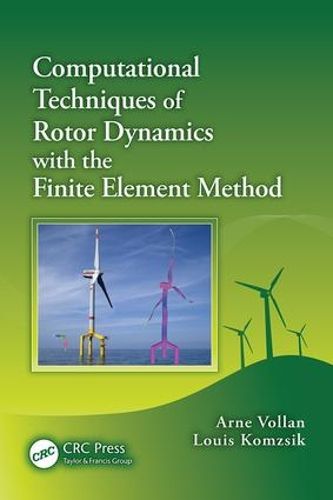Readings Newsletter
Become a Readings Member to make your shopping experience even easier.
Sign in or sign up for free!
You’re not far away from qualifying for FREE standard shipping within Australia
You’ve qualified for FREE standard shipping within Australia
The cart is loading…






For more than a century, we have had a firm grasp on rotor dynamics involving rigid bodies with regular shapes, such as cylinders and shafts. However, to achieve an equally solid understanding of the rotational behavior of flexible bodies-especially those with irregular shapes, such as propeller and turbine blades-we require more modern tools and methods.
Computational Techniques of Rotor Dynamics with the Finite Element Method explores the application of practical finite element method (FEM)-based computational techniques and state-of-the-art engineering software. These are used to simulate behavior of rotational structures that enable the function of various types of machinery-from generators and wind turbines to airplane engines and propellers.
The book’s first section focuses on the theoretical foundation of rotor dynamics, and the second concentrates on the engineering analysis of rotating structures. The authors explain techniques used in the modeling and computation of the forces involved in the rotational phenomenon. They then demonstrate how to interpret and apply the results to improve fidelity and performance.
Coverage includes:
Use of FEM to achieve the most accurate computational simulation of all gyroscopic forces occurring in rotational structures Details of highly efficient and accurate computational and numerical techniques for dynamic simulations
Interpretation of computational results, which is instrumental to developing stable rotating machinery Practical application examples of rotational structures’ dynamic response to external and internal excitations An FEM case study that illustrates the computational complexities associated with modeling and computation of forces of rotor dynamics Assessment of propellers and turbines that are critical to the transportation and energy industries
Useful to practicing engineers and graduate-level students alike, this self-contained volume also serves as an invaluable reference for researchers and instructors in this field.
CRC Press Authors Speak
Louis Komzsik introduces you to two books that share a common mathematical foundation, the finite element analysis technique. Watch the video.
$9.00 standard shipping within Australia
FREE standard shipping within Australia for orders over $100.00
Express & International shipping calculated at checkout
For more than a century, we have had a firm grasp on rotor dynamics involving rigid bodies with regular shapes, such as cylinders and shafts. However, to achieve an equally solid understanding of the rotational behavior of flexible bodies-especially those with irregular shapes, such as propeller and turbine blades-we require more modern tools and methods.
Computational Techniques of Rotor Dynamics with the Finite Element Method explores the application of practical finite element method (FEM)-based computational techniques and state-of-the-art engineering software. These are used to simulate behavior of rotational structures that enable the function of various types of machinery-from generators and wind turbines to airplane engines and propellers.
The book’s first section focuses on the theoretical foundation of rotor dynamics, and the second concentrates on the engineering analysis of rotating structures. The authors explain techniques used in the modeling and computation of the forces involved in the rotational phenomenon. They then demonstrate how to interpret and apply the results to improve fidelity and performance.
Coverage includes:
Use of FEM to achieve the most accurate computational simulation of all gyroscopic forces occurring in rotational structures Details of highly efficient and accurate computational and numerical techniques for dynamic simulations
Interpretation of computational results, which is instrumental to developing stable rotating machinery Practical application examples of rotational structures’ dynamic response to external and internal excitations An FEM case study that illustrates the computational complexities associated with modeling and computation of forces of rotor dynamics Assessment of propellers and turbines that are critical to the transportation and energy industries
Useful to practicing engineers and graduate-level students alike, this self-contained volume also serves as an invaluable reference for researchers and instructors in this field.
CRC Press Authors Speak
Louis Komzsik introduces you to two books that share a common mathematical foundation, the finite element analysis technique. Watch the video.